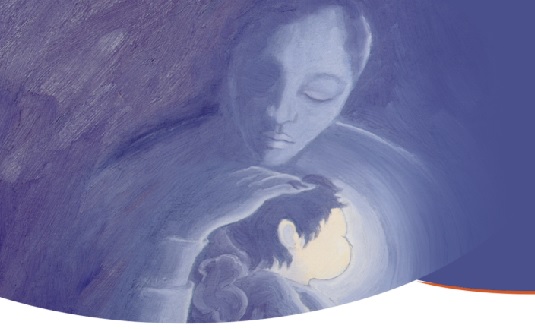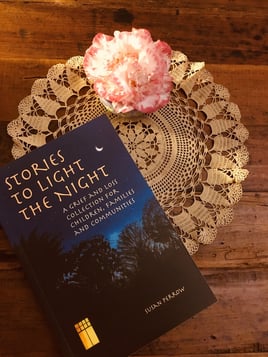By Jessica Horne-Kennedy, Manager Professional Learning, Gowrie NSW
Storytelling Integral to Practice
As I read the many stories in the collection – ‘Stories to Light the Night’ by Susan Perrow and published by Hawthorn Press, I am reminded of the children, I taught in my years as a practicing early childhood teacher, who were living with experiences of loss.

Storytelling was integral to my practices, and I saw stories as being like a bridge between a child’s inner emotional experiences and their outer world experiences. I felt at ease telling stories about the day-to-day experiences of the children, nature and their experiences of the world however telling a story that provided healing and care for experiences of trauma was an unknown practice for my teaching – something that would take a different kind of courage to approach. For those who are sitting with these similar thoughts and asking: Where do I start? Could I make a mistake? I believe that the book I am holding now –‘Stories to Light the Night’ provides an invitation to begin this process of providing support to children and families we work with. As Susan shares:
Therapeutic stories are a healing medium that allows children, teenagers and adults to embark on an imaginative journey, rather than being lectured or directly addressed about the issue. (…) the listener is empowered as obstacles are overcome and a resolution achieved. This is a gentle, easy, yet often effective means of addressing challenging behaviours and difficult situations (Perrow, 2021, p. 21).
Stories for healing and support
 The first image we are presented with on the cover of the book “Stories to Light the Night” by Susan Perrow is one that evokes feelings of warmth and hope -feelings that are universally associated with safety and comfort are reflected throughout this collection of stories that nurture the very essential human need of safety and connection in times of loss. In the forward, Alida Gersie Ph.D. presents statistics indicating just how many children in the UK alone experience grief and loss on a very personal level. Gersie says that these children “…will have to come to grips with the lasting absence of somebody who was important them…” (Perrow, 2021, p.9).
The first image we are presented with on the cover of the book “Stories to Light the Night” by Susan Perrow is one that evokes feelings of warmth and hope -feelings that are universally associated with safety and comfort are reflected throughout this collection of stories that nurture the very essential human need of safety and connection in times of loss. In the forward, Alida Gersie Ph.D. presents statistics indicating just how many children in the UK alone experience grief and loss on a very personal level. Gersie says that these children “…will have to come to grips with the lasting absence of somebody who was important them…” (Perrow, 2021, p.9).
By drawing on her experiences as a facilitator of therapeutic story-writing seminars, Susan Perrow recalls how grief and loss were a thread shared by many participants. This resource collection was born from a need in the community to provide tools to respond to a very real issue and Susan does this with sensitivity and care in an accessible and authentic manner. Susan suggests that this is not a book to read from cover to cover but rather a book that one can pick up and reference for scenarios and occasions that arise. The ten ‘story sections’ provide ‘stepping in’ points for the reader to connect with a story that provides healing and support for a specific scenario. For example, the story ‘A Handkerchief for Little Possum’ - found in the section ‘loss of health and wellbeing’ was written in response to Covid-19 at a time when many children were experiencing feelings of anxiety. While the story ‘The Rainbow Gnomes and the Cave of Secrets’ contributed by Élodie Guidou – a kindergarten teacher- responds to a social need observed in a group of preschool children to support collaboration and connection.
Relationships are fundamental to children's wellbeing
 Other stories included in this rich collection are contributed by doctors, social workers, psychologists, and musicians to respond to lived experiences of environmental loss and grief, loss of place as well as cycles of life and change. Alongside the stories are practical tools like the ‘random story writing exercise’ and patterns and templates for crafting props to accompany the storytelling experience.
Other stories included in this rich collection are contributed by doctors, social workers, psychologists, and musicians to respond to lived experiences of environmental loss and grief, loss of place as well as cycles of life and change. Alongside the stories are practical tools like the ‘random story writing exercise’ and patterns and templates for crafting props to accompany the storytelling experience.
Early childhood educators are strongly aware of how attuned relationships are fundamental to enabling wellbeing for children. Susan Perrow echoes this by emphasising the important role that close, sensitive observation plays in creating a responsive storytelling experience – where both the teller and the listener can experience nourishment and healing (Smyth, 2006). By ‘sensing the right time and place to share a therapeutic story’ we draw on the gesture of ‘being present’ and are mindful of the situation of another person’s experience. The stories in this resource are invaluable for those working with both young children as well as older children and their families because they provide a way to deepen our connections and relationships with others to create wholeness, belonging and wellbeing.
Tuesday 27th July, join pioneering storyteller Susan Perrow in a webinar at Gowrie NSW
The Healing Power of Stories.
.jpg?width=180&name=download%20(2).jpg)
Susan Perrow is an author, storyteller, parent educator and teacher trainer, with twenty years teaching experience in Australia and Africa. In 2000 she developed the first course on Storytelling for an Australian University (S.C.U.). and completed her Masters Research on Storytelling in a cross-cultural situation (post-apartheid South Africa). From 2001 to 2003 she was funded by the Australian Government to pilot creative courses and storytelling resources for children with challenging behaviour – CARE Program, Byron Council.Today her time is spent writing, consulting with teachers, parents and therapists, and running seminars on story therapy. She travels nationally and internationally, plus offers different forms of online training. Susan has three resource books, ‘Healing Stories for Challenging Behaviour’, ‘Therapeutic Storytelling’ and ‘An A-Z Collection of Behaviour Tales’. Published by Hawthorn Press, UK, these have since been translated into many languages. Find testimonials and book information here.
More Gowrie NSW Webinars here





